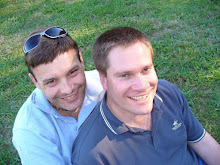There’s something magical about Port Douglas. I can’t quite put my finger on it. Is it the wonderfully warm and sunny weather, even in the depth of winter? Is it the casual, friendly lifestyle the locals enjoy? Or is it the comfortable blend of quality venues and affordable alternatives offering an atmosphere more refined than your average package tour destination? Regardless, I find myself falling in love with Port Douglas each time I visit (and secretly grateful that more Australians have yet to discover its seductive charm).
I first visited the town in 1993, spending several days relaxing with my parents. I returned again in 2002 to hang out for a week with a friend. Garry and I made our first visit together three years later. We cashed in credit card loyalty points for weekend at the gloriously opulent Sheraton Mirage. Last month we visited again, joining family and friends for the wedding of Garry’s younger brother. I’ll then be back in later in the year to witness a solar eclipse sweep through the area shortly after dawn on November 14.
Port Douglas is located 70km north of Cairns in Far North Queensland. It sits on a short coastal headland framed by a sweeping beach to the east and a sheltered mangrove harbour to the west. It offers one of the shortest transits to the Great Barrier Reef, making it a popular launching point for divers and snorkelers. Garry’s brother, David, works as a dive boat guide and runs his own diving accessories store in the town.
Port Douglas is located 70km north of Cairns in Far North Queensland. It sits on a short coastal headland framed by a sweeping beach to the east and a sheltered mangrove harbour to the west. It offers one of the shortest transits to the Great Barrier Reef, making it a popular launching point for divers and snorkelers. Garry’s brother, David, works as a dive boat guide and runs his own diving accessories store in the town.
We had a wonderful time last month enjoying the wedding festivities. David and his fiancée, Katie, were married just offshore on the deck of the same dive boat on which they first met three years ago. It was a truly romantic moment witnessing their vows as the sun began slowly sinking on the horizon. An informal reception was later held at the popular Courthouse Hotel.
The last time Garry and I came up this way we only drove as far as the Daintree River itself. On that occasion we joined one of the popular crocodile-spotting tours, as well as stopping off for a tour of the Mosman Sugar Mill. During this trip, the sugar cane was still in the field, in full flower, but clearly approaching harvest time. The sugar industry's prominent role in my local economy was clearly evident as field after field of cane lined the road north.
After crossing Daintree by ferry we made our first stop at Waluwurrigga, also known as Alexandra Point Lookout. The view from the summit of this mountain pass is stunning. Travelers are treated to a breath-taking view over the mouth of the meandering Daintree River and along the wild, curving coastline.
Our next stop was Coconut Beach, an enormous expanse of white sand sweeping along the coast for miles. Sadly, our uninterrupted view was spoilt by a distant couple walking the surf line. I couldn’t help comparing this vast empty expanse of sand with that of the cluttered, heavily-developed beaches of the Mediterranean coast.
The beach population more doubled at Myall Beach, just east of Cape Tribulation. However, a handful of people still left us feeling alone and at peace. Unfortunately, the same couldn’t be said of Cape Tribulation itself. We arrived shortly before a busload of tourists swept across its tidal reaches. Despite their noisy presence, I can honestly say that this is still one of the prettiest beaches in Australia. There’s something wonderfully unforgettable about its verdant tropical rainforest sweeping down from a cloud-shrouded mountain to the beach’s very edge.
While the empty beaches were manna for the soul, the day’s highlight came during our return home. Incredibly, we rounded a corner and came face to face with a Cassowary shepherding two juvenile birds across the road. It was a magic moment; right up there with a Moose family we’d once encountered crossing the road in Alaska.
Our final day in town was actually spent just north of Cairns. Garry and I spent a relaxing afternoon taking the Skyrail cable car over the Macalister Range to Kuranda village. It’s an awe-inspiring 7.5km ride gliding over the canopy of pristine tropical rainforest. Your journey begins by rising over the winding local highway as increasingly spectacular views of Cairns and the tropical coast unfold in front of you. Two interim stops then break up the remaining ride. First, Red Peak Station where a boardwalk takes you past soaring Kauri trees and then a stop opposite the imposing Barron Falls.
We flew Jetstar home. It the first Jetstar flight for both of us. We were pleasantly surprised by the experience. At check-in we were reseated in an exit row, with nobody occupying the middle seat. As a result, we enjoyed plenty of leg and elbow room all the way home. Even Garry had to admit our inaugural Jetstar experience had proven far better than the ugly Easyjet frat house jaunt we’d expected.


























































